Dissecting code language updates to lightning protection systems
by arslan_ahmed | October 9, 2023 8:00 pm
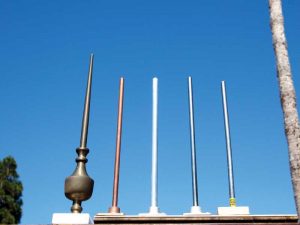 [1]
[1]By Brad Van Dam and Tim Harger
A bolt of lightning can produce anywhere from 100 million to one billion volts and strikes, and contains billions of watts of power, according to National Geographic. In fact, energy from lightning heats the air briefly to around 27,760 C (50,000 F) according to the National Oceanic and Atmospheric Association (NOAA).
It is no wonder lightning poses such a threat to property with potentially significant damages. In 2018 (latest data available), insurance companies paid nearly $1 billion in lightning-related claims to some 78,000 policy holders, according to the Lightning Protection Institute (LPI). Beyond physical building damage, lightning poses a threat to data, security, and all electrical and electronic components in a building. LPI estimates $1.7 trillion in data was lost in one year alone. In addition, approximately 3 to 5 percent of all commercial insurance claims involve lightning, which is a reliably preventable issue. A properly designed, installed, inspected, and certified lightning protection and grounding system can virtually mitigate this risk to policyholders and the public.
To help prevent structural damage and loss due to lightning strikes, many commercial building owners have opted to have a lightning protection system (LPS) installed.
What is a lightning protection system?
According to NFPA 780, the National Fire Protection Association’s (NFPA’s) ANSI standard for lightning protection systems in North America includes five fundamental elements:
-
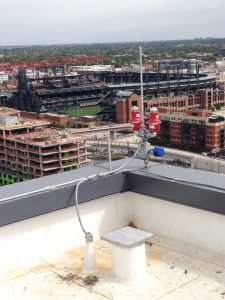 [2]
[2]When completed correctly, lightning protection systems (LPS) integrate effectively with roofing systems. Air terminals or strike termination devices. Strike termination devices, formally known as lightning rods, are installed on high points of a building. Their purpose is to intercept lightning before it hits the building, or a building component, and lead the electrical charge to the ground. Air terminals can be solid, and either pointed or blunt tipped, and are typically made of copper or aluminum alloy.
- Cable conductors. Cable conductors are heavy-duty metal cables that connect the air terminals and other components to provide a path for the lightning current to follow to the below-grade grounding electrode system. Conductor cables are often braided, but can be solid, and are typically made of copper or aluminum.
- Bonding connections. Bonding is the interconnection of the LPS to other internally grounded metallic systems on the structure, such as vent stacks and AC units. Bonding creates a path for lightning current and helps prevent lightning from side-flashing or arching to other metallic systems in the building.
- Grounding electrodes. Grounding electrodes are typically copper-clad steel rods, typically 3 m (10 ft) long, that are connected to the conductors and driven into the ground at multiple points around the building.
- Surge-protection devices. Wherever power or signal wires enter a building, Type 1 surge protection devices specifically configured for lightning must
be installed to stop the intrusion of lightning from utility lines and equalize differences between grounded systems during lightning events.
In addition, according to the LPI, it is also important the LPS is installed, inspected, and certified by a professional trained in installing these systems, and that the installed system meets the standards outlined in NFPA 780, Standard for the Installation of Lightning Protection Systems or in UL 96A, Installation Requirements for Lightning Protection Systems.
Code language updates
The International Building Code (IBC) is updated in multiple steps, based on annual review cycles. In 2021, the Group A Cycle included updates to Chapter 27, which covers “electrical” issues such as LPS. It was during this cycle that language referencing two different standards commonly used by LPS installers—NFPA 780 and UL 96A—was first added to the building code in Chapter 27. While the update does not mandate lightning protection equipment be installed on commercial buildings, it does require compliance with either NFPA 780 or UL 96A when lightning protection equipment is installed.
However, what the update language nor the referenced standards do not cover is how such systems should be secured to existing roofing components. The addition of this language to the 2024 IBC, led by The Single Ply Roofing Industry (SPRI), the trade association representing the manufacturers of single-ply roofing systems and the related component materials, to take action to clarify how LPS components should be secured to edge metal and other tested roofing components. The specific wording added to Section 2703 for the 2024 IBC, under Lightning Protection Systems, reads as follows:
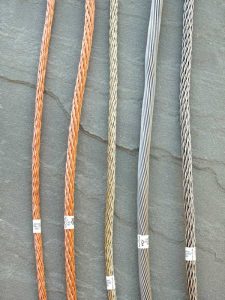
Section 2703 Lightning Protection Systems
- 2703.1 General. Where provided, lightning protection systems shall comply with Sections 2703.2 through 2703.3.
- 2703.2 Installation. Lightning protection systems shall be installed in accordance with NFPA 780 or UL 96A. UL 96A shall not be utilized for buildings used for the production, handling, or storage of ammunition, explosives, flammable liquids or gases, and other explosive ingredients including dust.
- 2703.2.1 Surge protection. Where lightning protection systems are installed, surge protective devices shall also be installed in accordance with NFPA 70 and either NFPA 780 or UL 96A, as applicable.
- 2703.3 Interconnection of systems. All lightning protection systems on a building or structure shall be interconnected in accordance with NFPA 780 or UL 96A, as applicable.
The NFPA 780 standard dates to 1904, and has been revised and updated regularly since then, with NFPA’s stated purpose to “provide for the safeguarding of persons and property from hazards arising from exposure to lightning.”
The current standard is 118 pages long and defines and details the components of a LPS, including the diameter, material composition, and cross section area of air terminals, main conductor cables, bonding conductors, etc. It also specifies air terminal height, and material requirements for air terminals, cable, brackets, and even fasteners. The standard also provides great details about air terminal placement, which varies based on the building height, roof slope and/or design, as well as cable placement, and ground rod installation depending on the soil composition.
UL examines LPS components and completed installations for compliance with their standards and has been testing and certifying lightning protection equipment since 1908. UL 96A addresses the minimum requirements for installation of air terminals, cable conductors, fittings, connectors,
and fasteners used in quality LPS.
Current IBC code language and roofing industry concerns
Edge metal components such as fascia, coping, and gutters are required by the building code to be tested to resist specific wind loads. When LPS components are attached to these tested edge components, there is a concern in the roofing community the LPS may alter wind load or system performance of fascia, coping, and gutters. This is critical to the roof design, as the edge system is the roof’s first line of defense when it comes to severe weather. The perimeter of a low slope commercial roof is a critical protection point for roofing assemblies relative to wind pressures and water infiltration. Estimates from insurance carriers including Factory Mutual (FM) indicate the failure of roof perimeters represents nearly 59 percent of roofing system failures in high wind events.
In addition to the edge metal, the roofing system or assembly, which includes all components from the roof deck up (e.g. deck, air barrier, insulation, membrane, fasteners, adhesives), is often tested and approved for use through FM. While not a code requirement, FM wind ratings are based on tested roofing assemblies. Any alterations to the component parts of the roofing assembly, such as insulation type or thickness, deck type or grade, fasteners, etc., can impact the assemblies’ performance, have significant implications for the building owner and nullify the FM rating. As such, adding lightning protection to the roofing system also impacts its FM rating.
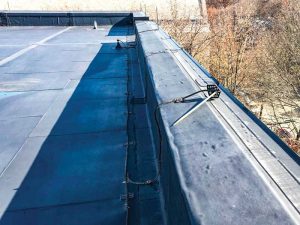 [3]
[3]The combination of the two guiding installation standards for LPS—NFPA 780 and UL 96A—being added to the code, and concerns from SPRI members about how lightning system are attached, precipitated the need for SPRI to act to address this situation and the code update.
A task force was established to seek and build cooperation between the commercial roofing and lightning protection industries, with the goal of clarifying the code language regarding how LPS, when used, should be secured to the roof or perimeter edge metal system without negatively impacting the wind rating or system performance.
Initial meetings and discussions were held with LPI, UL Solutions, the National Electrical Manufacturers Association (NEMA), and NFPA, who were all interested in working together for clarification to the language, which would come in the Group B code development cycle in 2022.
Following these discussions, and as part of the Group B Cycle, a proposed new language was drafted and sent to the organizations that SPRI had been working with, and submitted in January 2022, as an update to Chapter 15, “Rooftop Structures,” which had not been updated in the earlier review cycle.
The wording added to Chapter 27 in the first phase of the code update was focused on installing lightning protection, but there was nothing about maintaining or protecting the integrity of the roofing system, which is covered in Chapter 15 of the code and a critical consideration in the process. The specific original wording (S43-22) was as follows:
[BG] 1511.7, Other rooftop structures. Rooftop structures not regulated by Sections 1511.2 through 1511.6 shall comply with Sections 1511.7.1 through 1511.7.5 6, as applicable.
1511.7.6, Lightning Protection Systems. Lightning protection system components shall be installed in accordance with Section 1511.7.6.1. Lightning protection systems shall not be attached directly to metal edge systems, including gutters, where these roof assembly components are required to be tested to ANSI/SPRI/FM 4435-ES-1 or ANSI/SPRI GT-1 in accordance with Sections 1504.6 or 1504.6.1.
Exception: Where permitted by the manufacturer’s installation instructions for the metal edge systems or gutters.
1511.7.6.1, Installation. Lightning protection system components directly attached to or through the roof covering shall be installed in accordance with this chapter and the roof covering manufacturer’s installation instructions. Flashing shall be installed in accordance with the roof assembly manufacturer’s installation instructions and Sections 1503.2 and 1507 where the lightning protection system installation results in a penetration through the roof plane.
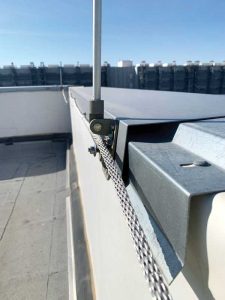 [4]
[4]Proposed updates or changes to the IBC go through a series of developmental process steps. The first is during a committee action hearing. Approval of a proposed change at this stage is based on a simple majority vote by a technical committee. Further changes are subject to a public comment hearing in front of the International Code Committee’s (ICC) governmental membership. In both steps of the process, testimony, arguments and opposing viewpoints are verbally presented about the proposed changes. However, once the proposed change reaches the public comment hearing step, revisions to the code then require approval by two-thirds of the ICC’s governmental voting members.
In early April 2022, the ICC held a committee action hearing on this topic. Some from the lightning industry attended the hearing and spoke out against the proposed new language. The ICC technical committee disapproved the proposed language in a resounding 13 to one vote with the following commentary:
Committee Reason: Disapproved as adding an exception for the attachment is inappropriate. The committee stressed that the proposal needs additional coordination between disciplines.
Issues with the originally proposed language
From the lightning protection industry’s perspective, there were several critical problems with the draft language presented. According to the NFPA and UL standards, lightning protection must be installed around the outmost perimeter of a structure, within 0.6 m (2 ft) of the edge and fastened every 0.9 m (3 ft). The reason for this design is to ensure the LPS is located on the portions of the structure to which lightning is typically attracted. The wording from the updated language was in direct conflict with the standards, as noted below:
- Lightning rods (strike termination devices) are required to be within 0.6 m (2 ft) of the outside corner. Not allowing the lightning protection industry to attach to the coping would make this impossible, especially on rooftop objects such as cameras, antennas, or any items that project over the top of the coping and are on the outer edge of the building.
NFPA 780 Section 4.7.2.1 states: “As shown in Figure 4.7.2.1, the distance from the strike termination devices to ridge ends on pitched roofs or to edges and outside corners of flat or gently sloping roofs shall not exceed 2 ft.” Similar language is provided in UL 96A, Section 8.1.5.2.
-
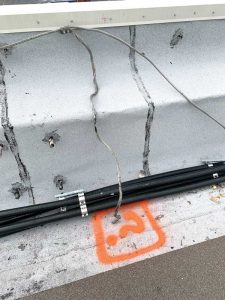 [5]
[5]The integration of lightning protection systems (LPS) and roofing systems often leads to questions surrounding penetrations and sequencing. Lightning rods are required to be installed around the perimeter at 6 m (20 ft) intervals. It is not just the corners this proposal would compromise. Depending on the width of the coping, every lightning rod could be affected.
NFPA 780 Section 4.7.2.2 states “Strike termination devices shall be placed on ridges or pitched roofs and around the perimeter of flat or gently sloping roofs at intervals not exceeding 20 ft.” Similar language is provided in UL 96A, Section 8.2.2.1.
- Lightning protection conductors are required to be attached every 0.9 m (3 ft) maximum. This creates a problem all to itself. If the conductors are fastened to the membrane, it will create many holes in the membrane. If the assembly requires brackets, it will require many brackets, making it problematic to coordinate the exact layout, timing, warranty, etc.
NFPA 780 Section 4.10, “Conductor Fastener. Conductors shall be fastened to the structure upon which they are placed at intervals not exceeding 3 ft.” Similar language is provided in UL 96A, Section 9.1.5.
Building consensus
The next step was to generate new language and submit it for public comment. Over the course of the next several months, SPRI reached out to several other industry organizations for meetings and discussions about this issue. Meetings were held with representatives from UL Solutions, LPI, the United Lightning Protection Association (ULPA), the National Roofing Contractors Association (NRCA), the Asphalt Roofing Manufacturers Association (ARMA), the Roof Coating Manufacturers Association (RCMA), the NEMA, and others to come to consensus on a public comment revising the language from what was originally proposed.
After several months of discussions and meetings, new draft language was developed jointly by SPRI and the lightning protection industry with assistance from UL Solutions, RCMA, NRCA, ARMA, NEMA and others, and submitted for public comment. In the fall of 2022, the ICC public comment hearings were held. During the meeting, the public comment language was approved by two-thirds of the ICC Governmental Voting Membership and ratified via
a subsequent online vote, thereby solidifying the new language, provided below, which will be published in the 2024 edition. The IBC is due out in the fall of 2023 and will then be ready for adoption by states and jurisdictions across the U.S. and internationally.
During the public comment hearing, representatives from National Association of Home Builders (NAHB), the United Lightning Protection Association (ULPA), UL Solutions and others spoke in favor of the modified language, which addressed earlier concerns of the lightning and home building industries.
Revised code language in 2024
Essentially, the new language goes beyond the existing installation standards outlined in NFPA 780 and UL 96A. While the new language does not impact the placement or spacing of the lightning protection equipment, it clarifies that attaching LPS components to any part of the roofing system or assembly must be installed in accordance with the manufacturer’s installation instructions or specifications from a qualified design professional for the roof assembly, roof covering, metal edge systems, or gutter. Where LPS components are secured to, or penetrate the roof, they must be properly flashed.
The new language reads as follows:
1511.7 Other rooftop structures. Rooftop structures not regulated by Sections 1511.2 through 1511.6 shall comply with Sections 1511.7.1 through 1511.7.6.2, as applicable.
1511.7.6 Lightning Protection Systems. Lightning protection system components shall be installed in accordance with Sections 1511.7.6.1, 1511.7.6.2, and 2703 of this code.
1511.7.6.1 Installation on metal edge systems or gutters. Lightning protection system components attached to ANSI/SPRI/FM 4435/ES-1 or ANSI/SPRI GT-1 tested metal edge systems or gutters shall be installed with compatible brackets, fasteners, or adhesives,
in accordance with the metal edge systems or gutter manufacturer’s installation instructions. When metal edge system or gutter manufacturer is unknown, installation shall be as directed by a registered design professional.
1511.7.6.2 Installation on roof coverings. Lightning protection system components directly attached to or through the roof covering shall be installed in accordance with this chapter and the roof covering manufacturer’s installation instructions. Flashing shall be installed in accordance with the roof assembly manufacturer’s installation instructions and Sections 1503.2 and 1507 where the lightning protection system installation results in a penetration through
the roof covering. When the roof covering manufacturer is unknown, installation shall be as directed by a registered design professional.
Conclusion
It is important to understand protecting the integrity of the building envelope is critical. Commercial roofing contractors are not experts in lightning protection installation, and lightning installers are not roofing experts. It is therefore the specifier’s or system manufacturer’s responsibility to clearly document how the roofing and LPS effectively interface, for the benefit of the building structure, equipment, occupants, and owner.
The 2024 IBC will be available for adoption by individual jurisdictions beginning in 2024. However, even if it has not yet been adopted for a specific jurisdiction, the impact of LPS on the performance of roof systems needs to be considered. Moving forward, manufacturers of edge metal systems and roofing materials will need to work with the lightning protection industry to provide clear installation instructions for this equipment, in conjunction with the roofing system.
It is also important to remember the IBC is written to benefit society, building owners, and occupants. There will always be conflicts among the various component providers, which need to be addressed and resolved by all parties. Building consensus is time consuming, difficult and requires compromise by all entities, for the overall benefit of the building owner and occupants.
Authors
- [Image]: https://www.constructionspecifier.com/wp-content/uploads/2023/10/AirTerminal-Photo.jpg
- [Image]: https://www.constructionspecifier.com/wp-content/uploads/2023/10/Coors-Field-Background.jpg
- [Image]: https://www.constructionspecifier.com/wp-content/uploads/2023/10/IMG_4011.jpg
- [Image]: https://www.constructionspecifier.com/wp-content/uploads/2023/10/IMG_4252.jpg
- [Image]: https://www.constructionspecifier.com/wp-content/uploads/2023/10/ES1.jpg
Source URL: https://www.constructionspecifier.com/dissecting-code-language-updates-to-lightning-protection-systems/
 Brad Van Dam is the vice-president of sales for MTL Holdings, the parent company of Metal-Era, Citadel Architectural Products, and Hickman Edge Systems. Van Dam is currently the president of Single Ply Roofing Industry (SPRI) Inc., the trade association representing the manufacturers of single-ply roofing systems and the related component materials. He attended Southwestern College in Chula Vista, California. In addition to SPRI, Van Dam is also a member of the International Institute of Building Enclosure Consultants (IIBEC), and the Roofing Industry Committee on Weather Issues Inc. (RICOWI).
Brad Van Dam is the vice-president of sales for MTL Holdings, the parent company of Metal-Era, Citadel Architectural Products, and Hickman Edge Systems. Van Dam is currently the president of Single Ply Roofing Industry (SPRI) Inc., the trade association representing the manufacturers of single-ply roofing systems and the related component materials. He attended Southwestern College in Chula Vista, California. In addition to SPRI, Van Dam is also a member of the International Institute of Building Enclosure Consultants (IIBEC), and the Roofing Industry Committee on Weather Issues Inc. (RICOWI). Tim Harger is an industry expert with an entrepreneurial spirit. For more than 35 years, he has engaged in all aspects of the lightning protection industry: manufacturing, installation, and inspection. His desire to maintain high standards comes from his involvement with ANSI accreditation and the ISO certification processes. Harger holds a BS in industrial technology from Iowa State University
Tim Harger is an industry expert with an entrepreneurial spirit. For more than 35 years, he has engaged in all aspects of the lightning protection industry: manufacturing, installation, and inspection. His desire to maintain high standards comes from his involvement with ANSI accreditation and the ISO certification processes. Harger holds a BS in industrial technology from Iowa State University